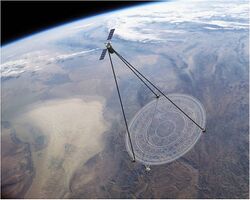Astronomy:Optical membrane
Membrane optics is a flat lens that employs plastic in place of glass to diffract rather than reflect or refract light. Concentric microscopic grooves etched into the plastic provide the diffraction.[1]
Glass transmits light with 90% efficiency, while membrane efficiencies range from 30 to 55%. Membrane thickness is on the order of that of plastic wrap.[1]
Applications
MOIRE program
DARPA plans to use membrane optics as part of its Membrane Optical Imager for Real-Time Exploitation (MOIRE) program. The program uses lightweight polymer membranes for a 20-meter (66 ft) foldable plastic orbital telescope capable of seeing a 1-meter (3 ft) object from 36,000 km (22,000 mi) away. Membrane grooves range from 4 to hundreds of micrometers in width.[1]
According to DARPA, glass-based optics in satellites are reaching the point where larger mirrors exceed the lifting power of existing rockets. The MOIRE devices is planned to be one-seventh the weight of a comparable glass-mirrored device.[1]
Individual membranes would be mounted on foldable metal petals. Once in geostationary orbit, the satellite would unfold. The membrane lens occupies one end and a sensor suite the other.[1]
The device would be the largest telescope ever built – twice the size of the ground-based twin 10-meter (33 ft) Keck telescopes. It could see about 40 percent of the Earth's surface and could image a 10 km × 10 km (6 mi × 6 mi) area at a 1-metre (3 ft) resolution and generate videos at one frame per second.[1]
A ground-based prototype consists of a section of a 5-meter (20 ft) wide device that created the first images with membrane optics.[1]
See also
References
- ↑ Jump up to: 1.0 1.1 1.2 1.3 1.4 1.5 1.6 "DARPA developing giant folding space telescope". Gizmag.com. 9 December 2013. http://www.gizmag.com/darpa-folding-telescope/30039/. Retrieved 2013-12-10.
External links
- "2013/12/05 First Folding Space Telescope Aims to "Break the Glass Ceiling" of Traditional Designs". Darpa.mil. 2013-12-05. http://www.darpa.mil/NewsEvents/Releases/2013/12/05.aspx. Retrieved 2013-12-10.
- Nautilus Space Telescope
 |


